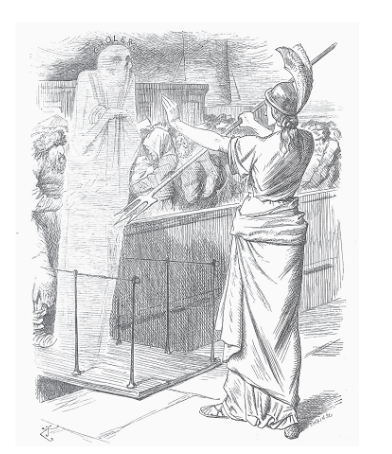‘Back!’: An Inspirational Image to A Wounded City
by Madison Lankford

‘”Back!”‘, Punch , vol. 103, 10 September 1892, p. 115. Courtesy Mary Couts Burnett Library, TCU
The illustrated cartoon ‘Back!’ was published in September of 1892 in volume 103 of Punch magazine (also known as The London Charivari), based in London, England. Punch was known for its satirical material since its founding in 1841. London at the tail end of the nineteenth century was notorious for its poor living conditions, a consequence of the rapid industrialization of the city. With an immense amount of grime, soot, and smog, the people of London were without a doubt susceptible to mass outbreaks of sickness (Cook and Werner).
John Tenniel, a native London resident and popular cartoonist and illustrator, was known for both his satirical political cartoons and children’s book illustrations (Curtis). Tenniel served as an editor and illustrator for Punch magazine for over a decade before retiring in 1901. Prior to his role at Punch, John Tenniel gained a reputation as a student at the Royal Academy of the Arts in London, as well as being the primary illustrator for Lewis Caroll’s Alice in Wonderland series (Curtis). Tenniel illustrated ‘Back!’ for Punch in September of 1892 for Punch vol. 103, following multiple Cholera outbreaks throughout the nineteenth century.
The cartoon, illustrated by political cartoonist John Tenniel, depicts Britannia, seemingly holding back a grim reaper-esque image of cholera personified. Britannia, a female warrior figure, stands alone on the opposite side of a dock connecting an incoming ship to the shore. ‘Cholera’ appears tall, surrounded by hooded, hunched figures. The ship represents cholera as a threat originating outside of Britain and is attempting to enter the country after afflicting its fellow passengers with sickness. A lack of color in the illustration sets a somber tone to the piece as a whole, but also offers simplicity, thus emphasizing the presence of Britannia. In standing head-to-head, the cartoon makes it apparent that Britannia is prepared to show resistance against foreign threats. The illustration served as propaganda to encourage diligence and strength during the deadly outbreak.
Britannia, a figurehead depicting unity, strength, and resilience, predates her prominence in the nineteenth century, as she had been a figure dating back as far as the Roman Empire (Matthews). It wasn’t until the seventeenth century that Britannia emerged again, this time in Great Britain, symbolizing the strength and power of the English monarchy. Britannia rose further into prominence during the reign of Queen Victoria in 1837, just a few years before her infamous depiction in Punch magazine, as she became synonymous with the female power of the reigning monarch (Walton).
Cholera first appeared in London in 1832. By 1966, over 100,000 people were infected and killed (Delahunty). Originating in Asia, Cholera became feared due to a lack of understanding by both the general public and medical professionals in the area (“Cholera”). Treatments were ineffective, and it was nearly 30 years before a direct source was identified. Dr John Snow, a physician in London, had researched the possibility of the various outbreaks being related to the public water sources (Frerichs). After removing several water pumps throughout the city, most notably the Broad Street pump in Soho, both infection and death rates significantly decreased. Dr. Snow and the London General Board of Health determined that cities’ sewage dumps had been contaminating the water in cities downstream of the Thames River, thus infecting the poorer populations of London, taking the lives of thousands during its 30-year pandemic (Frerichs).
It is observable that in times of panic, uncertainty, and fear, unity and strength are the best remedies for lifting spirits and encouraging health and fortune. In using a national figure of strength and pride, Punch magazine and John Tenniel sought to bring the people of London together, speaking a message of hope that the city’s collective spirit would drive hardship away. This image encouraged London residents to remain resilient together as one unified entity. ‘Back!’ was not merely a message of hope to a city of grieving, frightened people; it was also a promise that they would prevail over their hardships, inspiring the people to keep faith in each other, their officials, and their city.
Source:
Tenniel, John. ‘”Back!”‘, Punch, vol. 103, 10 September 1892, pp. 115. Courtesy Mary Couts Burnett Library, TCU
References:
“Cholera in Southeast Asia.” Centers for Disease Control and Prevention. 2022. https://www.cdc.gov/cholera/asia/index.html
Cook, Beverly; Werner, Agnes. “Breathing in London’s history: From the Great Stink to the Great Smog”. Museum of London. 24 August 2018.
Curtis, L. Perry. “Book review: Sir John Tenniel: Aspects of His Work.” Victorian Studies, vol. 40, 1996. pp. 168–171.
Delahunty, Andrew; Dignen, Sheila. “Britannia”, A Dictionary of Reference and Allusion (3rd ed.), 2010.
Frerichs, Ralph R. “John Snow and the removal of the Broad Street pump handle”. 2010. https://www.ph.ucla.edu/epi/snow/removal.html
Matthews, Roy. “Britannia and John Bull: From Birth to Maturity,” Historian, vol. 62, No. 4, 200 pp. 799-820.
Walton, Geri. “Victorian Event of the Season: 1897 Devonshire Costume Ball.” Unique histories from the 18th and 19th centuries. https://www.geriwalton.com/event-of-the-season-the-1897-devonshire-costume-ball/